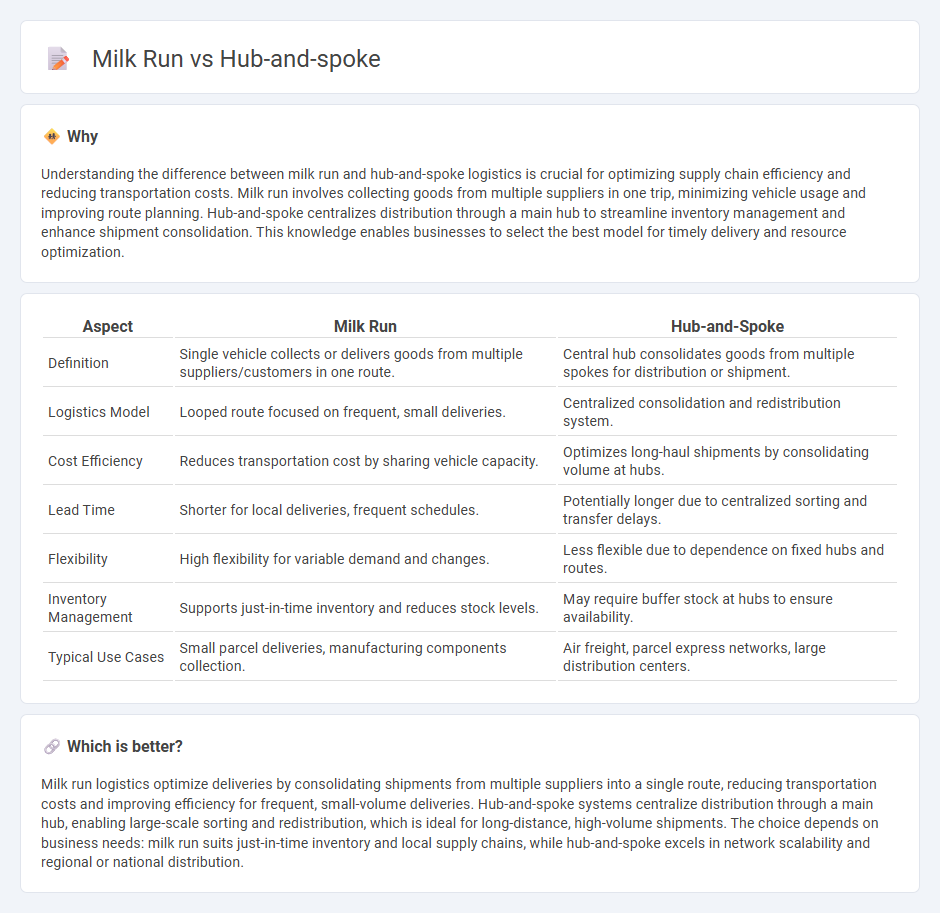
Milk run logistics optimizes supply chain efficiency by consolidating multiple deliveries into a single route, reducing transportation costs and improving inventory management. In contrast, hub-and-spoke systems centralize distribution through a main hub, enabling faster shipment consolidation and streamlined network coordination. Explore the key differences and benefits of milk run and hub-and-spoke logistics to enhance your supply chain strategy.
Why it is important
Understanding the difference between milk run and hub-and-spoke logistics is crucial for optimizing supply chain efficiency and reducing transportation costs. Milk run involves collecting goods from multiple suppliers in one trip, minimizing vehicle usage and improving route planning. Hub-and-spoke centralizes distribution through a main hub to streamline inventory management and enhance shipment consolidation. This knowledge enables businesses to select the best model for timely delivery and resource optimization.
Comparison Table
| Aspect | Milk Run | Hub-and-Spoke |
|---|---|---|
| Definition | Single vehicle collects or delivers goods from multiple suppliers/customers in one route. | Central hub consolidates goods from multiple spokes for distribution or shipment. |
| Logistics Model | Looped route focused on frequent, small deliveries. | Centralized consolidation and redistribution system. |
| Cost Efficiency | Reduces transportation cost by sharing vehicle capacity. | Optimizes long-haul shipments by consolidating volume at hubs. |
| Lead Time | Shorter for local deliveries, frequent schedules. | Potentially longer due to centralized sorting and transfer delays. |
| Flexibility | High flexibility for variable demand and changes. | Less flexible due to dependence on fixed hubs and routes. |
| Inventory Management | Supports just-in-time inventory and reduces stock levels. | May require buffer stock at hubs to ensure availability. |
| Typical Use Cases | Small parcel deliveries, manufacturing components collection. | Air freight, parcel express networks, large distribution centers. |
Which is better?
Milk run logistics optimize deliveries by consolidating shipments from multiple suppliers into a single route, reducing transportation costs and improving efficiency for frequent, small-volume deliveries. Hub-and-spoke systems centralize distribution through a main hub, enabling large-scale sorting and redistribution, which is ideal for long-distance, high-volume shipments. The choice depends on business needs: milk run suits just-in-time inventory and local supply chains, while hub-and-spoke excels in network scalability and regional or national distribution.
Connection
Milk run and hub-and-spoke logistics models enhance supply chain efficiency by optimizing transportation routes and minimizing costs. Milk run consolidates multiple deliveries or pickups in a single trip, while hub-and-spoke centralizes distribution through a main hub that connects smaller spokes or destinations. Integrating both strategies improves inventory management, reduces transit time, and maximizes resource utilization in distribution networks.
Key Terms
Centralized Distribution
Centralized distribution optimizes inventory flow by consolidating shipments at a central hub before dispatching to multiple destinations, enhancing efficiency in the hub-and-spoke model. In contrast, the milk run system focuses on multiple pickups or deliveries in a single route, minimizing transport costs and improving supply chain responsiveness. Explore more to understand which centralized distribution method best suits your logistics strategy.
Route Optimization
Hub-and-spoke route optimization centralizes shipments through a main hub, reducing transportation costs by consolidating cargo and minimizing direct routes from origin to multiple destinations. Milk run route optimization involves multiple pickups and deliveries along a predefined loop, enhancing efficiency by maximizing vehicle utilization and reducing empty miles. Explore detailed comparisons to optimize your logistics strategy further.
Consolidation
Hub-and-spoke logistics centralizes consolidation at a main hub, optimizing load efficiency by grouping shipments from multiple origins before distribution to final destinations. Milk run consolidation involves a single vehicle collecting smaller loads from multiple suppliers directly, reducing transportation costs and improving frequency. Explore the advantages and applications of each method to enhance your supply chain efficiency.
Source and External Links
What is a Hub-and-Spoke Network: 9 Tips, Benefits & Limitations - The hub-and-spoke network is a centralized model where a central hub coordinates and communicates directly with all partner spokes, streamlining decision-making, resource allocation, and communication.
Spoke-hub distribution paradigm - Wikipedia - The hub-and-spoke system is a transport topology where spokes connect outlying points to a central hub, optimizing routes compared to the point-to-point system and widely used in aviation and logistics since the 1950s.
Hub-spoke network topology in Azure - Azure Architecture Center - In Azure's hub-spoke topology, a central hub virtual network hosts shared services and connectivity gateways while spoke virtual networks connect through the hub, supporting managed routing, traffic control, and cross-premises connectivity.
 dowidth.com
dowidth.com